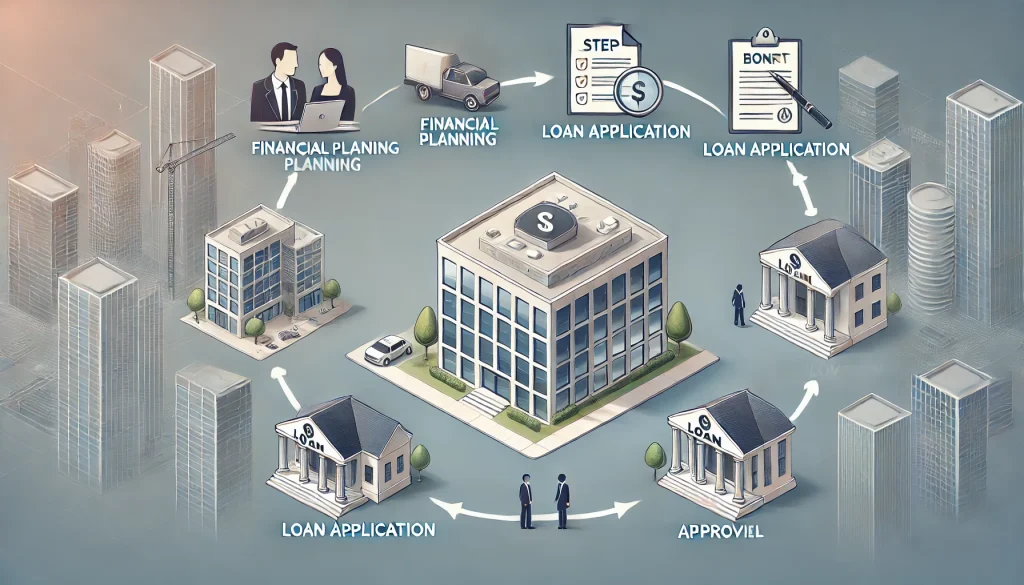How to Secure a Commercial Real Estate Loan in 2025: Step-by-Step

Securing a commercial real estate loan is a pivotal step for any business looking to expand or establish itself in the real estate market. Unlike residential loans, commercial real estate loans are more complex, requiring thorough preparation, understanding of the terms, and navigating through multiple processes. Whether you’re seeking a loan to purchase an office space, retail outlet, or industrial facility, the process can seem overwhelming. This step-by-step guide will break down how to secure a commercial real estate loan, ensuring you are well-prepared and set up for success.
Table of Contents
1. What is a Commercial Real Estate Loan?
A commercial real estate loan is a mortgage used to buy, develop, or refinance commercial properties like office buildings, warehouses, shopping malls, and apartment complexes. Unlike residential loans, commercial loans often require higher down payments and have shorter terms. The repayment structure of these loans can vary greatly depending on the type of loan and the lender’s policies.
2. Types of Commercial Real Estate Loans
Understanding the types of commercial loans available can help you choose the right one for your needs. Below are some of the most common types:
a. Permanent Loans
These are traditional mortgage loans with fixed or variable interest rates. They are often used for the purchase or refinance of established properties and typically have terms ranging from 5 to 30 years.
b. Construction Loans
These loans are designed for businesses or developers who plan to construct new commercial properties. They cover construction costs and are generally short-term, transitioning into permanent financing once construction is complete.
c. Bridge Loans
Bridge loans are temporary loans meant to cover the gap between the purchase of one property and the sale of another. They provide short-term financing to borrowers who need immediate cash flow.
d. SBA 504 Loans
Offered by the Small Business Administration (SBA), these loans are designed to help small businesses purchase fixed assets such as commercial property. The SBA covers up to 40% of the loan, a lender finances up to 50%, and the borrower covers the remaining 10%.
e. Mezzanine Loans
Mezzanine financing blends debt and equity. If a borrower defaults, the lender can convert the loan into an equity stake in the property. These loans are commonly used for expansion and growth but tend to come with higher interest rates.
f. Hard Money Loans
These are asset-based loans typically used for quick financing. They are offered by private lenders and secured by the property itself. Interest rates are high, and the terms are shorter, usually between one to five years.
3. Step-by-Step Guide to Securing a Commercial Real Estate Loan
Step 1: Assess Your Financial Situation
Before applying for a commercial loan, it’s essential to evaluate your finances. Lenders will assess your creditworthiness, which includes:
- Credit Score: A strong credit score (typically 700 or above) significantly increases your chances of securing favorable loan terms.
- Debt-to-Income Ratio: Ensure your business generates enough income to manage additional debt. Aim for a debt-to-income ratio under 45%.
- Assets and Liabilities: Lenders will assess your current assets, liabilities, and cash flow to ensure you can afford the down payment and monthly payments.
Step 2: Understand Loan Requirements
Lenders typically require a variety of qualifications to approve a commercial real estate loan. Key criteria include:
- Collateral: Most commercial real estate loans require the property itself as collateral, though additional assets may also be needed.
- Down Payment: Down payments can range from 15% to 35% of the purchase price depending on the loan type.
- Loan-to-Value (LTV) Ratio: The LTV ratio indicates the loan amount compared to the property’s value. For commercial properties, LTV ratios typically range between 65% and 80%.
Step 3: Research Lenders
Not all lenders offer the same terms or loan products, so it’s crucial to research various financial institutions. Options include:
- Banks: Traditional banks offer competitive interest rates but tend to have stricter lending criteria.
- Credit Unions: Credit unions may offer more flexible terms, especially for smaller loans.
- Private Lenders: Private lenders are less regulated than banks and may offer more flexible loans, such as hard money or bridge loans, with higher interest rates.
- Government Programs: SBA loans are backed by the government, offering more lenient terms for small businesses.
Step 4: Gather Required Documentation
Gather all the necessary documents to present to the lender. These typically include:
- Personal and Business Tax Returns: The lender will assess both your personal and business financial history.
- Financial Statements: Submit profit and loss statements, balance sheets, and cash flow statements to show your business’s health.
- Appraisal of the Property: A commercial real estate appraisal will determine the market value of the property.
- Business Plan: Prepare a comprehensive business plan that outlines the purpose of the loan and the potential for revenue generation.
Step 5: Prepare a Strong Business Plan
A solid business plan is critical for securing a loan. Your business plan should include:
- Executive Summary: Briefly explain the purpose of the loan and how it will contribute to your business’s growth.
- Market Analysis: Provide data on market trends, property demand, and the competitive landscape.
- Revenue Projections: Present a detailed forecast of potential revenue based on market analysis and past business performance.
- Loan Repayment Strategy: Clearly outline how you plan to repay the loan.
Step 6: Submit the Loan Application
Once you’ve gathered all necessary documents, you can submit your loan application. The application typically includes personal information, business details, and property information. Be prepared to submit:
- Completed Loan Application Form: Every lender has their own form, which must be filled out completely.
- Financial History: Attach your financial statements and tax returns.
- Property Details: Include details like property address, square footage, and appraisal report.
Step 7: Underwriting Process
The underwriting process is where the lender thoroughly evaluates your financial situation, creditworthiness, and the value of the property. During this stage, the lender may request:
- Additional Documentation: Be ready to submit more financial records if requested.
- Property Inspection: The lender will likely perform an inspection of the property to ensure it meets their standards.
The underwriting process typically takes anywhere from a few weeks to a few months, depending on the complexity of the loan.
Step 8: Loan Approval and Closing
Once the underwriting process is complete and the lender is satisfied with all the information provided, the loan will move to the approval stage. During the closing, you will:
- Sign Loan Documents: These include promissory notes, mortgage documents, and personal guarantees (if applicable).
- Pay Closing Costs: These typically range from 2% to 5% of the loan amount and may include appraisal fees, legal fees, and origination fees.
- Receive Loan Funds: After closing, the loan funds will be disbursed to purchase or develop the property.
4. Tips to Increase Your Chances of Loan Approval
Securing a commercial real estate loan can be challenging, but following these tips can improve your chances of success:
a. Improve Your Credit Score
A higher credit score signals to lenders that you are financially responsible. Work on reducing your debt and ensuring all bills are paid on time before applying.
b. Offer a Larger Down Payment
Providing a larger down payment can demonstrate to the lender that you have significant skin in the game, reducing their risk.
c. Choose the Right Loan
Ensure that the loan you apply for fits your needs and the property in question. For instance, if you’re purchasing an underdeveloped property, a construction loan might be more appropriate than a permanent loan.
d. Consult a Commercial Real Estate Loan Broker
A broker can guide you through the complex world of commercial real estate loans, helping you find the best deals and avoiding potential pitfalls.
5. Common Challenges and How to Overcome Them
a. High Interest Rates
Commercial real estate loans often come with higher interest rates than residential loans. To mitigate this:
- Negotiate Loan Terms: Speak to multiple lenders to find competitive rates.
- Refinance in the Future: If interest rates drop, consider refinancing your loan to secure a lower rate.
b. Lengthy Underwriting Process
The underwriting process can be time-consuming. To streamline it:
- Be Prepared: Have all documents organized and ready for submission to avoid delays.
- Maintain Open Communication: Keep in contact with your lender to address any questions or concerns promptly.
c. Complex Legal Requirements
Commercial real estate transactions often involve complex legalities. To avoid complications:
- Hire a Real Estate Attorney: A qualified attorney can help navigate legal challenges and ensure your interests are protected.
6. Conclusion
Securing a commercial real estate loan is a detailed process that requires careful planning, research, and preparation. By following the steps outlined in this guide—evaluating your financial situation, understanding loan types, gathering necessary documents, and choosing the right lender—you can significantly increase your chances of securing the loan you need. With the right approach and strategic planning, your business can expand and thrive in the competitive commercial real estate market.
Whether you’re seeking to purchase your first commercial property or expand your portfolio, knowing how to navigate the loan process effectively will set you up for long-term success.



1 thought on “How to Secure a Commercial Real Estate Loan in 2025: Step-by-Step”